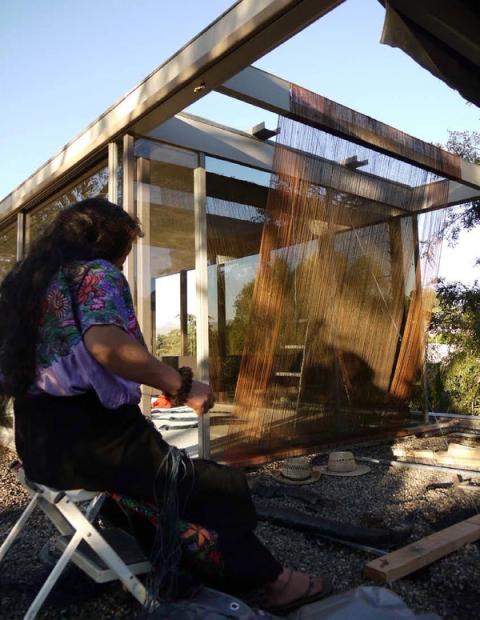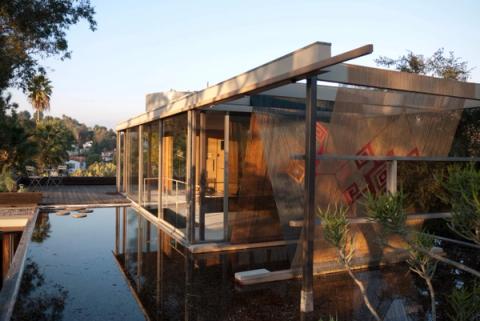Apr 1 —
May 8,
FORT DA / SAMPLER is a site-specific installation by Mexico City-based artist Santiago Borja. The artist and his collaborators have erected a temporary, functioning textile loom transform- ing the roof of architect Richard Neutra’s family home. Borja’s architectural intervention encourages new readings of this place, and what he sees as the elusive nature of “magical thinking” embedded in Modernism. The project grows from the formal similarities between modern abstract geometry and Mayan patterning used to represent the cosmos. In a free association manner, like in a trans-cultural patchwork, Santiago Borja links Neutra, Freud, and Mayan textile weavers.
I
The installation title comes from Borja’s study of Freud’s “Fort / Da” theory, which says symbol- ism allows us to manage the discrepancies between pleasure and reality. Freud developed his theory while watching a child repeatedly throw a wooden reel attached to a string over a ledge. The child would watch it disappear, retrieve it, and then throw it back again. Freud theorized this game was how the child managed his anxiety created by the absence of his mother. Borja takes this theory further, envisioning the act of throwing the reel as a way to trace an emotional space that visually and physically connects us to a distant place.
II
Situated directly across from the Silver Lake reservoir, Richard Neutra’s rooftop solarium was conceived as a place to connect the house and its inhabitants to the natural context. Follow- ing Neutra’s idea of Nature Near Nature Far, the rooftop’s surrounding 2inch pool of water is designed to act as a reflective mirror that is activated by the solarium’s low seating, allowing the viewer to make a relationship between the house and the reservoir.
III
The specific design used for the piece comes from a ceremonial Huipil (traditional dress) that has this motif embroidered repeatedly. The diamond shape design synthesizes the three layers in which the Mayan cosmos is conceived; Heaven, Earth and the Underworld. When dressed, the Huipil also transforms its user symbolically into the center of the universe. The cosmic coordinates are re-etched in the sleeves, and on the front and back of the dress. Additionally, a ceremonial Huipil integrates references to the Mayan ritual calendar, in which variation in thread colors and their patterns emphasize the cycles of the sun.
Regarding this and playing with perspective, Fort Da / Sampler deploys in space these three separate levels that get “flattened” from a precise point of view.
In Chiapas, as in other areas of Mexico, young apprentices establish their identity as textile weavers through the creation of several samplers that codify the entire textile language. The process of weaving and embroidering these samplers connects them to past, present, and future textile processes, creating a dialogue with the cosmic and natural world around them. Back-strap loom weaving is introduced as a game and subsequently the tradition is passed down from mother to daughter, fashioning a distinctive familial “signature,” permitting ancient designs and practices to remain culturally alive through generations While many other Pre-Columbian traditions continue to fade and become diluted by mainstream culture, Back-strap loom weaving is one of few traditions that persist as an integral part of their daily lives.
Fort Da / Sampler was supported by the Fundación / Colección Jumex, SNCA-FONCA Conaculta, g727 Gallery, the Neutra VDL Research House under the directorship of Sarah Lorenzen, and Big City Forum.



